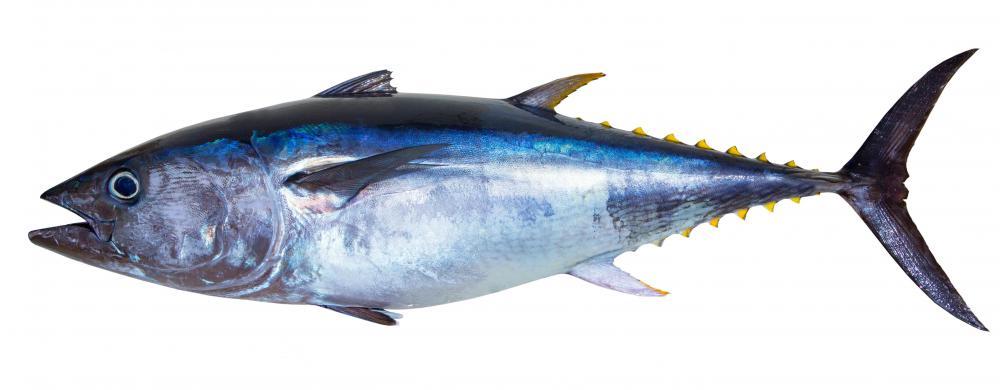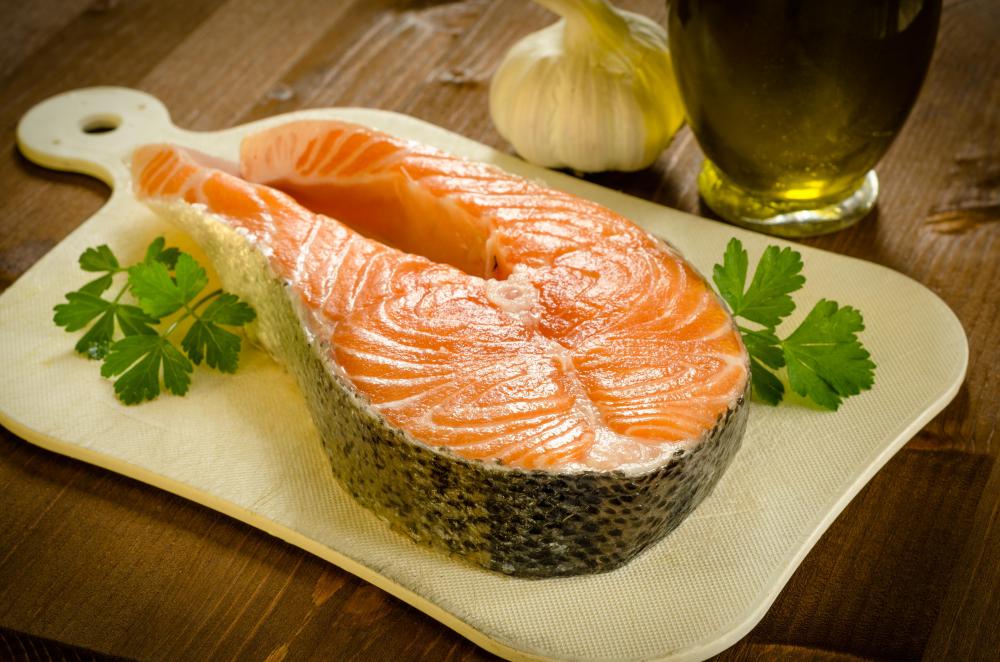At AllThingsNature, we're committed to delivering accurate, trustworthy information. Our expert-authored content is rigorously fact-checked and sourced from credible authorities. Discover how we uphold the highest standards in providing you with reliable knowledge.
What is a Skipjack Tuna?
The skipjack tuna is a saltwater fish found in many areas around the world, and is the most common commercially caught tuna. They are often used in Japanese cuisine as a substitute for yellowtail tuna, and are the primary tuna sold across the planet in cans as “fresh light” tuna. As with most fish, the skipjack tuna has many health benefits for consumers, including high levels of omega-3 fatty acids, DHA, and healthy protein.
Skipjack tuna live in almost every ocean in large shoals. Up to 50,000 fish may live together in one group. They generally prey on smaller fish, crustaceans, and mollusks and also provide a food staple for large predatory fish and sharks. Because they reproduce quickly and live in such large groups, their numbers are considered sustainable in comparison with how many tuna are caught by humans each year. They are also one of the healthiest fish for the same reason, thus providing more health benefits to people.

Generally, skipjack tuna is considered to be safe to eat, although they can be moderately high in mercury levels from contaminated water. For this reason, women who are pregnant should eat the fish in moderation. Those who are not pregnant can consume more safely, although lower mercury fish like salmon may be healthier options if fish is consumed multiple times per week.

Although the skipjack tuna itself is considered a fully sustainable commercial fish, they catching methods used for fishing are the topic of debate. Tuna nets frequently catch other species of fish and even some endangered animals such as turtles, sharks, and dolphins. This has resulted in many deaths of at risk seas creatures and has been heavily scrutinized by the environmentally conscious.

Aside from being purchased by millions of people each year in cans or frozen, the skipjack tuna is a very popular option in Japanese cuisine. The Japanese call the skipjack katsuo and typically make it smoked and dried. It is then added to other dishes or used as fish stock. It is also sometimes used as a less expensive option to the yellowfin tuna or yellowtail tuna, which is often pricier to buy and prepare.

The skipjack tuna can also be prepared in various other ways, including being grilled or broiled. Many recipes used for other types of fish like salmon can be applied to the skipjack. There are also pre-flavored and smoked options alongside the well known tuna cans, with tuna being sold in small pouches. This tuna can be served on crackers or in various recipes.
Frequently Asked Questions
What is a Skipjack Tuna?

Skipjack tuna, scientifically known as Katsuwonus pelamis, is a medium-sized, migratory fish found in tropical and warm-temperate waters. It's the most abundant and widely fished tuna species, recognized by its streamlined body, dark purplish-blue back, and silver belly with distinctive longitudinal stripes.
How big do Skipjack Tuna get?
Typically, skipjack tuna grow to about 1 meter (3 feet) in length and can weigh up to 18 kilograms (40 pounds). However, they are usually found at sizes around 0.5 meters (1.6 feet) and 2-8 kilograms (4-18 pounds), making them the smallest commercial tuna species.
What is the lifespan of a Skipjack Tuna?
Skipjack tuna have a relatively short lifespan compared to other tuna species, living up to 8-12 years. They grow rapidly and reach reproductive maturity quickly, which contributes to their resilience against fishing pressures.
What do Skipjack Tuna eat?

Skipjack tuna are opportunistic predators, feeding on a variety of prey including fish, crustaceans, cephalopods, and mollusks. Their diet varies with availability, which is influenced by the region and the time of year, but they predominantly hunt for small schooling fish such as anchovies and sardines.
Why is Skipjack Tuna important to fisheries?
Skipjack tuna is crucial to global fisheries due to its high reproductive rate and abundant population. According to the Food and Agriculture Organization, it accounts for approximately one-third of the total tuna catch worldwide, making it a key species for commercial fishing and a staple in canned tuna products.
Are Skipjack Tuna populations at risk?

While skipjack tuna populations are currently considered stable and not overfished, they face threats from overfishing, bycatch, and habitat degradation. Sustainable fishing practices and effective management are essential to ensure their populations remain healthy, as indicated by the International Seafood Sustainability Foundation's monitoring.
AS FEATURED ON:
AS FEATURED ON:

















Discussion Comments
I think if you're going to eat fish, tuna is a pretty good choice. As the article said, tuna is sustainable, unlike some other kinds of fish we like to eat. I personally think that it's important that we pay attention to environmental concerns and don't just worry about what tastes good!
I personally don't think the mercury thing is that big of a concern. I think as long as you aren't eating tuna at every single meal of the day, you should be okay.
@Azuza - Yeah, I'm pretty sure the tuna in a sushi roll is different than canned tuna (it's not cooked, for one thing!) But if you're ever curious, you could probably ask at the restaurant and they'll be able to tell you what kind of tuna you're eating.
Anyway, eating blue fin tuna or really any other kind of tuna has always seemed like a catch-22 to me. Because it is really good for you, as the article said. It's a healthy protein full of omega-3 fatty acids. But then you also risk consuming mercury when you eat tuna! So it seems like tuna is almost neutral, because the mercury kind of cancels out the benefits.
You know, I eat tuna pretty frequently, but I had no idea there was more than one kind! I think I probably eat both, because I eat canned tuna, but I also eat tuna in sushi a lot too.
Anyway, I have heard that bluefin tuna fishing does have a lot of unpleasant effects on the environment, specifically on dolphins. However, some brands of canned tuna market themselves as "dolphin friendly," meaning that they try not to harm the dolphins while they're fishing. I usually try to buy that kind when I shop for tuna in the grocery store.
@fBoyle-- In the past couple of years, commercial fishers are leaning more and more towards skipjack because like the article said, it's seen as more sustainable. In the past, tuna was usually bluefin but as bluefin tuna fishing increased, their numbers decreased greatly and commercial fishers have been preferring skipjack more as a result. So most of the canned or frozen tuna products in the market are probably skipjack.
The sad thing is that this type of tuna which companies thought were plentiful and would never run out, is decreasing at a very rapid rate. There was an article about it at my college paper that talked about this recently. The sustainability of skipjack seems to be under threat. For some reason, we can't put tuna on our table without endangering one species or another.
@burcinc-- That's a great question! As far as I know, canned tuna labeled as "chunk tuna" can be made of various different types of tuna including skipjack. And you are right that chunk tuna labels do not usually specify which exact fish meat is found in that particular can. The only canned tuna that cannot be skipjack is "white tuna", which is always made of albacore tuna only. If the label says "light tuna," then it is most likely skipjack tuna.
It is true that skipjack isn't the tuna lowest in mercury. So I recommend that you eat it in moderation, about once or twice a week. For kids, it should be even less, a couple of times a month at most.
So is all tuna sold canned in grocery stores skipjack tuna then? Or is it specifically labeled as skipjack?
I eat canned tuna several times a week. I like having tuna salad sandwich for lunch. Tuna keeps me full for a long time and I feel good knowing that I am getting extra Omega 3. But I have no idea what kind of tuna I'm eating, I don't think the can labels mention it either.
If what I'm eating is indeed skipjack tuna, am I at risk because of mercury? Can I get mercury poisoning from eating skipjack tuna often?
Post your comments